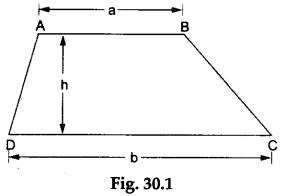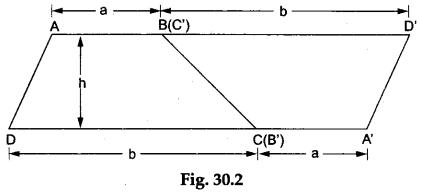Math Labs with Activity – Derive a Formula for Finding the Area of a Trapezium
OBJECTIVE
To derive a formula for finding the area of a trapezium.
Materials Required
- A sheet of white paper
- A sheet of glazed paper
- A geometry box
- A tube of glue
- A pair of scissors
Theory
It has been geometrically proved that the area of a trapezium is given by area = ½ x (sum of the parallel sides) x height.
Procedure
Step 1: Draw any trapezium ABCD in which AB || DC on a sheet of white paper as shown in Figure 30.1.
Let AB = a units and DC = b units and the height of the trapezium = h units.

Step 2: Make an exact copy of the trapezium on the glazed paper and label it as A’B’C’D’. Cut this trapezium. Rotate it and place it adjacent to the trapezium ABCD as shown in Figure 30.2.

Step 3: Record your observation.
Observations and Calculations
We observe that the quadrilateral AD’A’D formed by the combination of a trapezium ABCD and its exact replica A’B’C’D’ is a parallelogram. The base of this parallelogram=(a+b) units and its height = h units. Now,
∴ area of the parallelogram AD’A’D =2 x (area of trapezium ABCD).
area of trapezium ABCD = ½ x (area of parallelogram AD’A’D)
= ½ x (base of the parallelogram x height of the parallelogram)
= ½ x (a+b) x h
= ½ x (sum of the parallel sides) x height.
Result
The area of a trapezium is given by area = ½ x (sum of the parallel sides) x height.
Math Labs with ActivityMath LabsMath Lab ManualScience LabsScience Practical Skills
